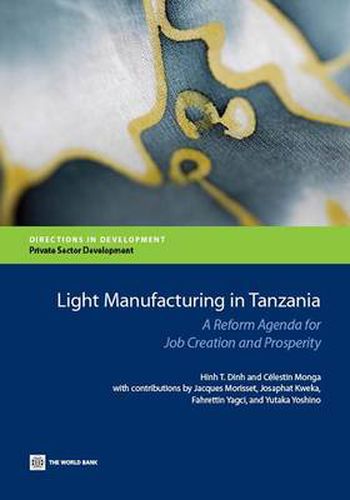Light manufacturing in Tanzania: a reform agenda for job creation and prosperity
Hinh T. Dinh,World Bank,Celestin Monga

Light manufacturing in Tanzania: a reform agenda for job creation and prosperity
Hinh T. Dinh,World Bank,Celestin Monga
Light Manufacturing in Tanzania argues that for Tanzania to remain one of the fastest growing economies in Sub-Saharan Africa, it has to make progress in the structural transformation that can lift workers from low-productivity agriculture and the informal sector to higher productivity activities. Manufacturing, which has been the main vehicle throughout the world to achieve this transformation, has remained stunted in Tanzania. Using new evidence, the book shows that feasible, low-cost, sharply focused policy initiatives aimed at enhancing private investment could launch Tanzania on a path to competitive light manufacturing. These initiatives would complement progress on broader investment reforms by increasing the share of industry in regional output and raising the market share of domestically produced goods in rapidly growing local markets for light manufactures. And, as local producers increase their scale, improve quality, and gain experience with technology, management, and marketing, they can take advantage of emerging export opportunities. In Tanzania, as in East Asia, policies that encourage foreign direct investment can speed industrial development and the expansion of exports. The impact of isolated successes can be multiplied. The strategies proposed here can launch a process that would create millions of productive jobs. Light Manufacturing in Tanzania has several innovative features. First, it provides in-depth cost comparisons between Tanzania and four other countries in Asia and Africa at the sector and product levels. Second, the book uses a wide array of quantitative and qualitative techniques to identify key constraints to enterprises and to evaluate differences in the performance of firms across countries. Third, it uses a focused approach to identify country - and industry - specific constraints. Fourth, it highlights the interconnectedness of constraints and solutions. For example, solving the manufacturing input problem requires actions in agriculture, education, and infrastructure. Detailed cross-country analysis was carried out in four subsectors in Tanzania: textiles and apparel, leather products, wood products, and agroprocessing. Based on this analysis, the book suggests directing government policies toward removing constraints in a few of the most promising light manufacturing sectors using practical and innovative solutions inspired by the fast-growing Asian economies.
This item is not currently in-stock. It can be ordered online and is expected to ship in approx 2 weeks
Our stock data is updated periodically, and availability may change throughout the day for in-demand items. Please call the relevant shop for the most current stock information. Prices are subject to change without notice.
Sign in or become a Readings Member to add this title to a wishlist.


